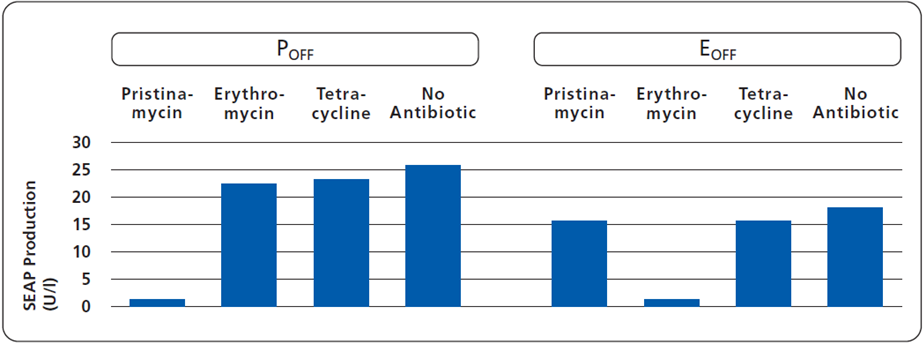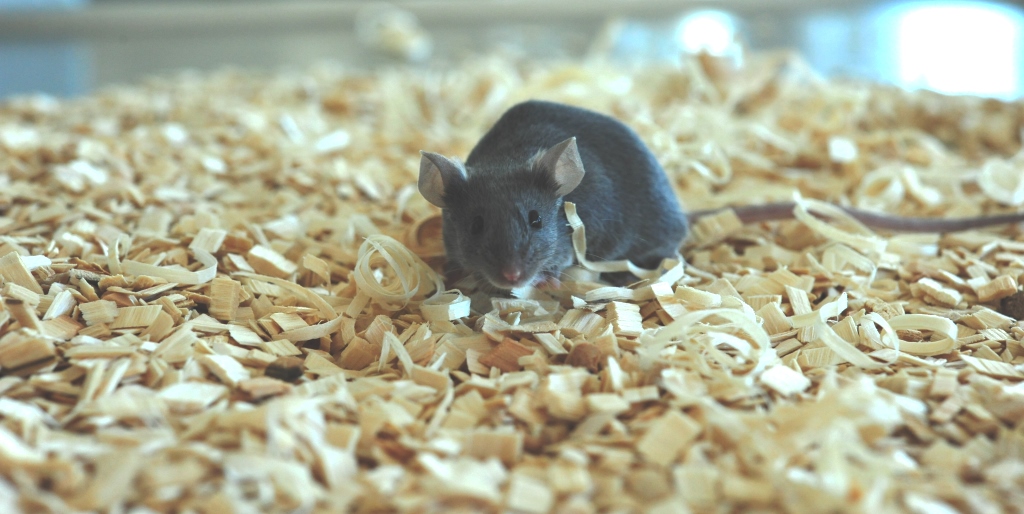PolyGene's Deactivator Systems.
PolyGene’s antibiotic-inducible expression systems are also available as DEACTIVATORS, i.e. Poff and Eoff (Pristinamycin- and Macrolide), respectively (, Weber et al, 2002).
Mode of Function
In their P
off and E
off versions, the co-expression of two distinct (EFFECTOR and RESPONDER) transgenes gives the possibility to modulate the expression of a given Gene Of Interest (GOI).
The EFFECTOR mouse expresses an Operator Binding Protein (OBP) which can be linked to further functional proteins, for example to a trans-activation (e.g. VP16) domain as represented here (Go). The RESPONDER mouse is engineered to harbour the GOI and a (e.g. CMV-derived) minimal promoter (Pmin), combined with Operator (O) DNA sequences, to which the OBP has binding affinity.
Transcription is de-activated by administration of the respective antibiotic, dissociating OBP from the operator and thus depriving the GOI of a functional activator.
Dose-Response
As demonstrated in CHO cell culture experiments, GOI expression is reduced by approximately 100-fold over respective antibiotic concentrations ranging from roughly 0.01 to 2 μg/ml (
Fussenegger et al, 2000,
Weber et al, 2002).

Reversibility
The responsiveness of SEAP producing E
off cells to recurrent addition and withdrawal of macrolide reveals a swift and efficient on/off state transition (
Weber et al, 2002).
Split cell cultures adjusted to 105 cells/ml in fresh medium at the indicated time-points (circled). macrolide (2 μg/ml) was added at t = 0, not added at t = 40 and added again at t = 90 hrs (black).
Culture with inversed Macrolide status: pink.
Independent Control
As demonstrated by interference studies on CHO cells co-transfected with pairs of EFFECTOR and RESPONDER elements, gene expression modulation is achieved with the system-compatible antibiotic, only (
Weber et al, 2002).

System Compatibility in vivo
In mice, the E
off system was proven to respond in a dose-dependent fashion (
Weber et al, 2002). Moreover, the availability of different systems for independent control of transgene expression RESPONDER mice, PolyGene will maintain various EFFECTOR mouse lines constitutively expressing the fused OBP at determined levels. Thus, mating of RESPONDER mice with different EFFECTORS(each of a given trans-activation potential) allows studying GOI expression beyond a 2-log range.
Since the initial (OFF-type) RESPONDER mouse does not express the GOI, DEACTIVATOR systems are also suited for investigating embryonic lethal genes.
The reputed excellence of both, streptogramins and macrolides, in terms of bioavailability and of low interference with host metabolism, distinguishes the Poff and Eoff systems for a variety of applications, including for pregnancy-related studies.
Reference
Fussenegger, M. et al.,
Streptogramin-based gene regulation systems for mammalian cells.
Nat. Biotechnol.18, 1203-1208 (2000)Weber, W. et al.,
Macrolide-based transgene control in mammalian cells and mice.
Nat. Biotechnol.20, 901-906 (2002)
Fux, C. et al.,
Streptogramin- and tetracycline-responsive dual regulated expression of p27Kip1 sense and antisense enables positive and negative growth control of Chinese hamster ovary cells.
Nucleic Acids Res.29, e19 (2001)
Kramer, B. et al.,
An engineered epigenetic switch in mammalian cells.
Nat. Biotechnol.22, 867-870 (2004)
« back







